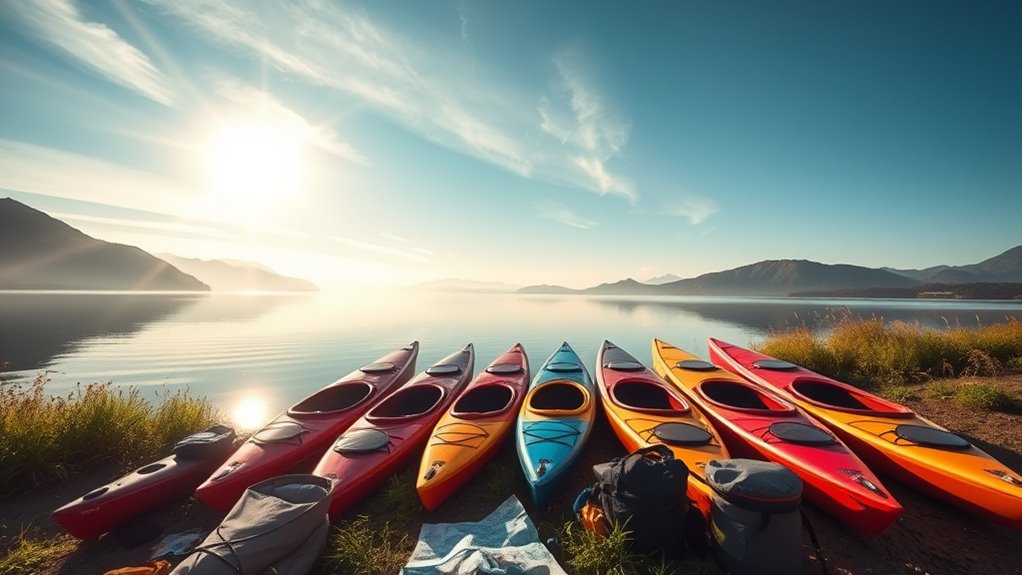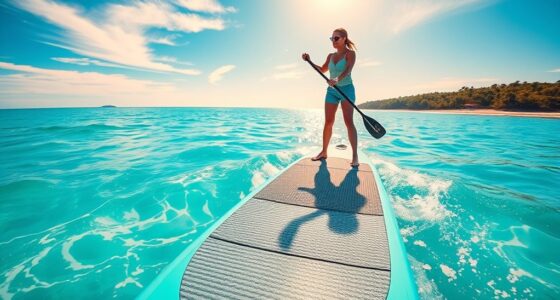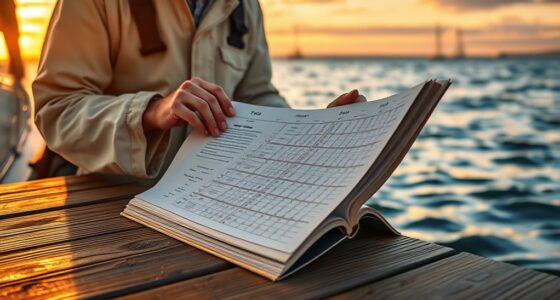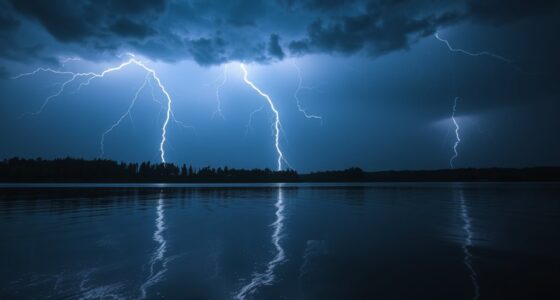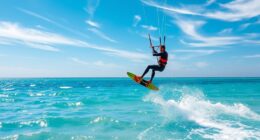To plan a multi-day kayaking trip, start by selecting a route with scenic viewpoints and suitable difficulty for your skill level. Check weather and water conditions often, and pick campsites with safe landing spots and shelter. Organize your gear, ensuring safety equipment and navigation tools are ready. Plan meals and water supply carefully, and communicate your itinerary with trusted contacts. If you want detailed steps, you’ll find how to prepare every aspect of your adventure below.
Key Takeaways
- Map out your route with scenic viewpoints, wildlife spots, and suitable campsites, considering difficulty level and weather conditions.
- Prepare a detailed daily itinerary with manageable paddling distances, scheduled rest breaks, and contingency plans.
- Pack safety gear, navigation tools, and weather-appropriate clothing, performing gear checks and safety drills before departure.
- Plan meals with lightweight, non-perishable foods, and ensure reliable water sources and communication devices are accessible.
- Monitor weather and water conditions regularly, select safe campsites, and stay in touch with trusted contacts for safety.
Selecting the Ideal Route and Destination
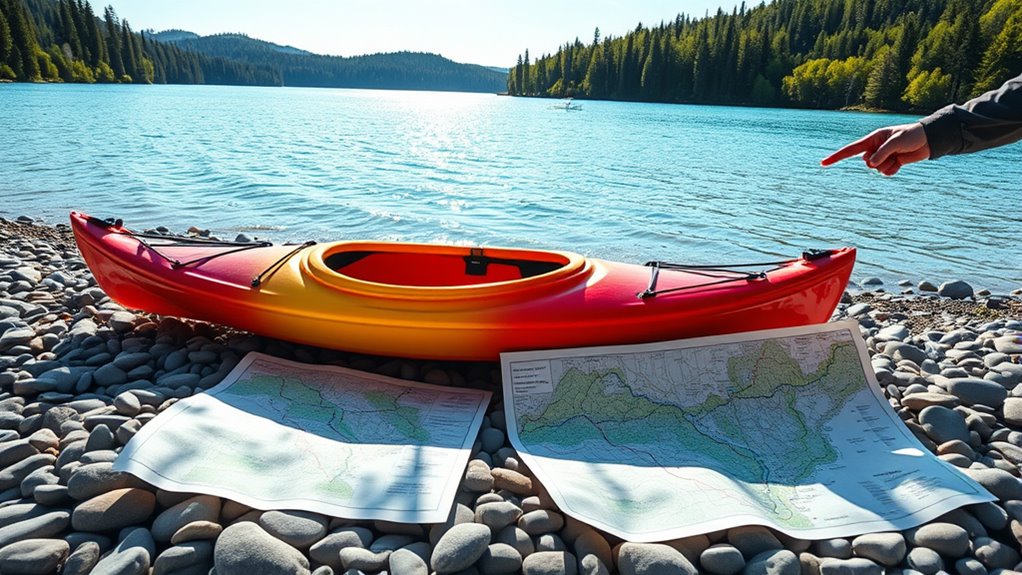
Choosing the right route and destination is essential for a successful multi-day kayaking trip. You want a route that offers stunning scenic viewpoints to keep you motivated and engaged throughout your journey. Look for waterways that pass through diverse landscapes, such as lush forests, rocky coastlines, or serene lakes. These spots not only provide breathtaking views but also opportunities to spot local wildlife, adding excitement to your adventure. Consider the difficulty level of the route to match your skill set, and verify it aligns with your trip goals. Planning a route with accessible campsites along the way will make your experience more enjoyable and manageable. Additionally, understanding the diverse landscapes you will encounter can help you better prepare for varying conditions and scenery. Being aware of the local ecology can also enhance your appreciation for the environment and improve your safety. Recognizing potential hazards in your chosen area is crucial for ensuring a safe and enjoyable trip. Ultimately, selecting a destination that combines natural beauty and wildlife viewing will make your kayaking trip memorable. To enhance your planning, understanding the IRA investment strategy can help you optimize your finances for future adventures. Moreover, implementing effective fraud prevention tools in your planning process can safeguard your trip investments and personal information.
Checking Weather and Water Conditions
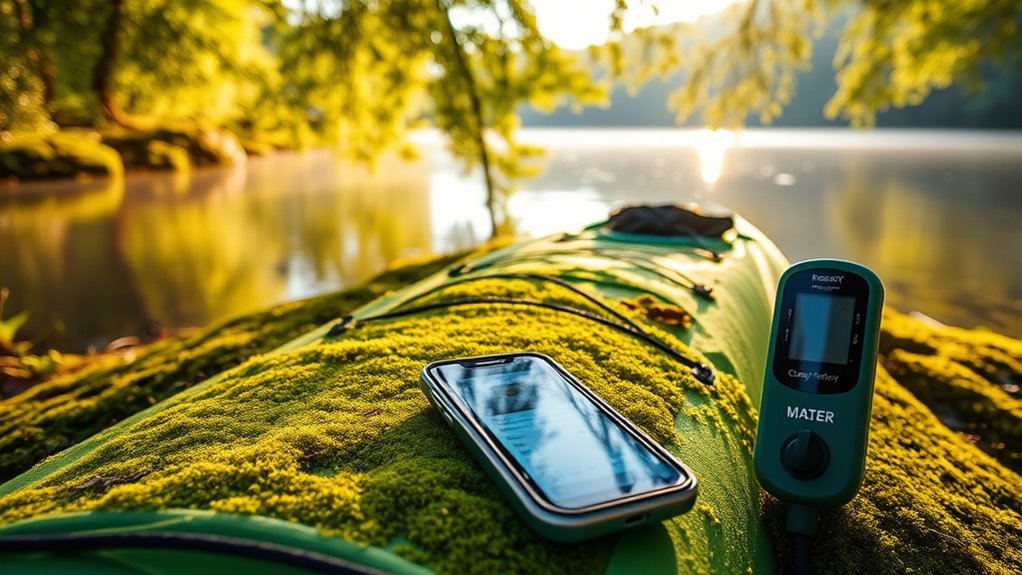
Before setting out on your kayaking adventure, it’s crucial to check both weather and water conditions to guarantee safety and enjoyment. Start by reviewing the weather forecast for your planned days, paying attention to wind speeds, storms, and temperature changes. Sudden weather shifts can make paddling dangerous or uncomfortable. Additionally, check water levels, as high water might indicate recent rain or flooding, while low water can expose hazards or restrict passage. Knowing the water levels helps you determine if your route is suitable or needs adjustments. Staying informed with local water reports can provide more accurate and timely information about current water conditions. Always stay updated with real-time weather alerts and water reports, especially for multi-day trips. Incorporating industry trends into your planning can help you understand potential risks and prepare accordingly. Moreover, understanding field recording techniques can enhance your ability to gather detailed environmental data, contributing to safer planning. Being aware of recent narcissistic behavior patterns among locals or guides can also help you better interpret signs of changing conditions and potential hazards. Properly understanding these conditions ensures you’re prepared for potential challenges and can adapt plans accordingly.
Planning Your Daily Itinerary and Campsites
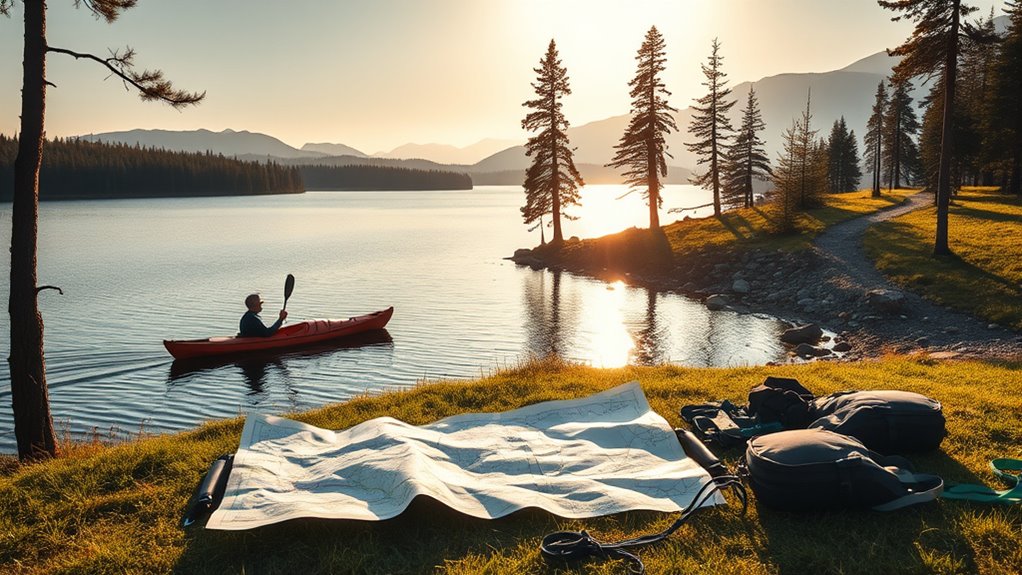
Start by mapping out how far you plan to paddle each day to stay on track. Choose campsites that are accessible and comfortable for resting overnight. Remember to include enough breaks to keep your energy up and enjoy the surroundings. Planning your grocery savings strategies in advance can also help ensure you have enough supplies without overpacking. Additionally, considering the space optimization and layout of your campsite can provide insights into efficient resource management during your trip. Understanding the cowboy heritage and natural landscapes of regions like Kansas can inspire you to incorporate scenic stops and cultural experiences along your route, making your kayaking adventure more enriching. Exploring top beach towns on the East Coast can inspire you with nearby amenities and scenic spots for your trip rest stops.
Map Out Daily Distances
Mapping out your daily distances is essential to guarantee a smooth and enjoyable kayaking trip. By planning your daily distances, you can better estimate travel times, ensuring you stay on schedule and avoid exhaustion. Use mapping distances to determine how far you can realistically paddle each day based on your skill level and weather conditions. Here’s a simple way to visualize your plans:
| Day | Distance (miles) | Estimated Travel Time |
|---|---|---|
| Day 1 | 15 | 4-5 hours |
| Day 2 | 20 | 5-6 hours |
| Day 3 | 18 | 4-5 hours |
| Day 4 | 22 | 6 hours |
| Day 5 | 16 | 4 hours |
Adjust these figures as needed, considering your pace and conditions. Proper planning minimizes surprises and keeps your trip enjoyable. Remember to incorporate safety considerations such as weather forecasts and water conditions into your daily planning. Additionally, understanding your paddling capacity helps ensure you set realistic goals for each day and maintain your energy levels throughout the journey. Being aware of local regulations can also help avoid unforeseen issues during your trip. It is also beneficial to review your route options to identify potential hazards or alternative campsites along your path.
Select Suitable Campsites
Choosing the right campsites is a key part of planning your kayaking trip, as it guarantees you have a comfortable place to rest each night. Look for spots that offer good shelter and are accessible from your daily route. Prioritize sites that allow safe landing and departure, ensuring campsite safety. Consider locations near areas rich in wildlife observation, so you can enjoy nature without disturbing the environment. Check for flat ground and minimal hazards like falling branches or unstable ground. Avoid camping too close to water sources, which can flood or attract unwanted wildlife. Selecting well-suited campsites helps you relax after a day on the water, while also ensuring safety and maximizing your opportunity for wildlife observation. Proper planning keeps your trip enjoyable and secure. Additionally, choosing campsites with odor control features can help reduce wildlife disturbances and enhance your overall experience. Being aware of AI and automation developments can also inform your planning, especially if you are relying on digital maps or weather forecasts during your trip. Incorporating safety considerations by researching local regulations and potential hazards further contributes to a successful adventure. For instance, using digital planning tools can streamline your campsite selection and route adjustments to improve safety and convenience.
Consider Rest Periods
Planning rest periods throughout your kayaking trip is essential to maintain energy and safety. Proper pacing strategies help prevent fatigue and reduce the risk of accidents. Incorporate regular rest stops to rehydrate, snack, and assess your progress. Keep in mind the rest period importance in maintaining stamina over multiple days.
Consider these tips:
- Schedule breaks every 1-2 hours to stay refreshed
- Use sheltered spots or beaches for comfortable rest
- Pay attention to your body’s signals of fatigue
- Adjust your daily mileage based on conditions and energy levels
Gathering Essential Gear and Supplies

Before hitting the water, it’s crucial to gather all the essential gear and supplies to guarantee a safe and enjoyable trip. Start with a thorough packing checklist to ensure nothing important is overlooked. Pack your safety gear, including life jackets, a first aid kit, and a whistle. Don’t forget navigation tools like maps or a GPS device. Conduct gear maintenance beforehand—check your kayak, paddles, and dry bags for damage or wear. Pack clothing suitable for the weather, along with sun protection like hats and sunscreen. Bring necessary tools such as a multi-tool or repair kit. Organize your gear efficiently to make access easy during the trip. Proper preparation here minimizes surprises on the water and helps keep everyone safe and comfortable throughout your multi-day adventure.
Organizing Food and Water Provisions
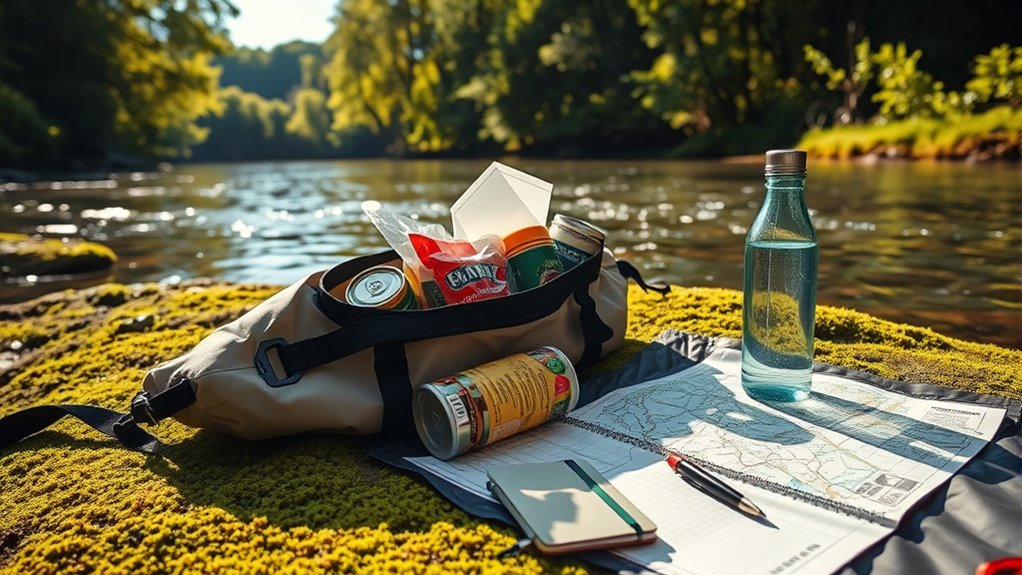
Since access to fresh food and water may be limited during your trip, organizing your provisions carefully is essential. Focus on effective meal planning and hydration strategies to stay energized and hydrated. Pack lightweight, non-perishable foods like trail mix, energy bars, dried fruits, and freeze-dried meals. Consider reusable water bottles and portable water filters to guarantee a steady water supply. Plan meals that are easy to prepare and consume on the go, reducing the need for extensive cooking gear. Incorporate hydration strategies such as drinking small amounts regularly and using electrolyte tablets. Keep your provisions organized in waterproof containers or dry bags to prevent spoilage and leaks. Staying disciplined about your food and water supplies helps maintain your stamina and safety throughout the trip.
Preparing Your Kayak and Safety Equipment
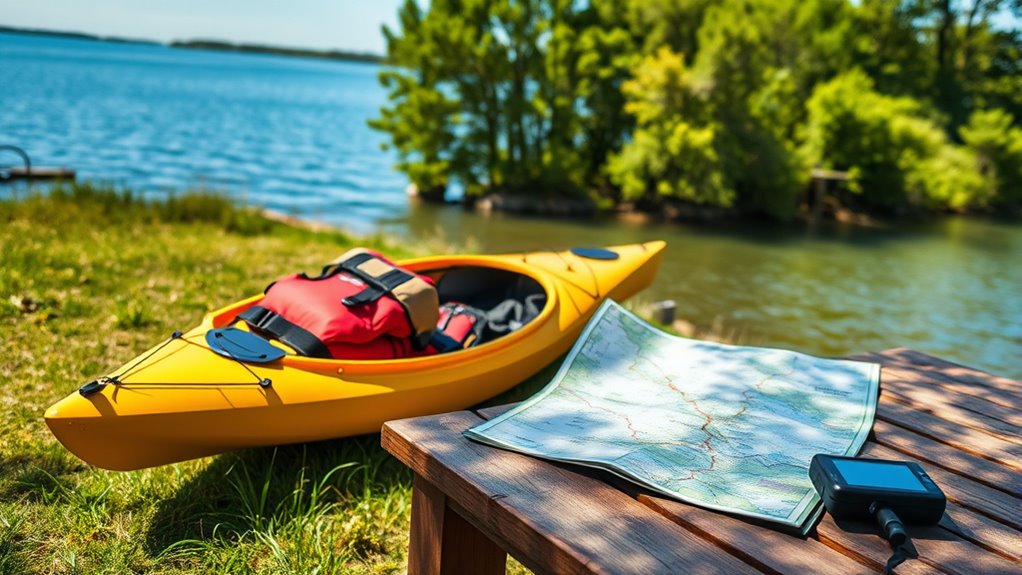
Ensuring your kayak and safety equipment are properly prepared is essential for a smooth and secure trip. Start with kayak maintenance—check for cracks, secure all fittings, and ensure the hull is clean. Inspect safety gear like life jackets, whistles, and lights, testing them for functionality. Performing safety drills before setting out builds confidence and readiness. Here’s a quick overview:
| Equipment | Checkpoint | Key Reminder |
|---|---|---|
| Kayak | Inspect for damage | Repair any issues |
| Safety Gear | Confirm proper fit | Test safety devices |
| Emergency Supplies | Pack waterproofly | Keep accessible |
Proper prep boosts your confidence and safety, making your adventure memorable and worry-free.
Communicating Your Plans and Emergency Preparedness
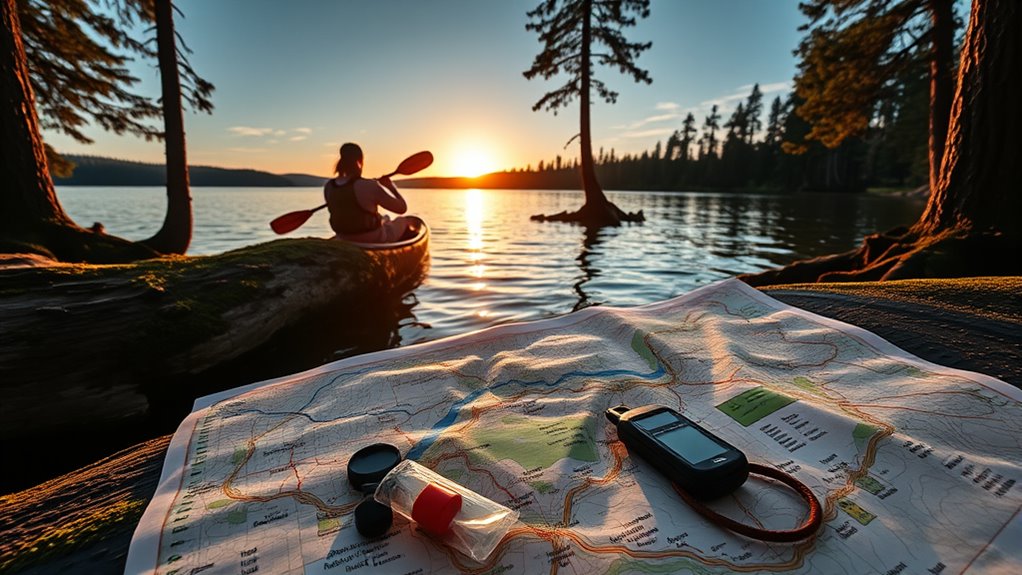
Once your kayak and safety gear are ready, sharing your plans with others and preparing for emergencies keeps your trip secure. Make sure to inform a trusted contact about your route, expected return time, and check-in points. Carry reliable communication devices like a waterproof radio, cell phone with a portable charger, or satellite messenger. These tools are essential for contacting emergency services if needed. Additionally, keep a list of emergency contacts accessible, including local rescue teams and friends or family. Clearly communicate your itinerary and safety procedures with your group. Regularly update your emergency contacts during your trip, especially if plans change. Being proactive with communication ensures help is reachable and your plans are known, making your multi-day kayaking adventure safer and more enjoyable.
Final Checklist and Trip Review
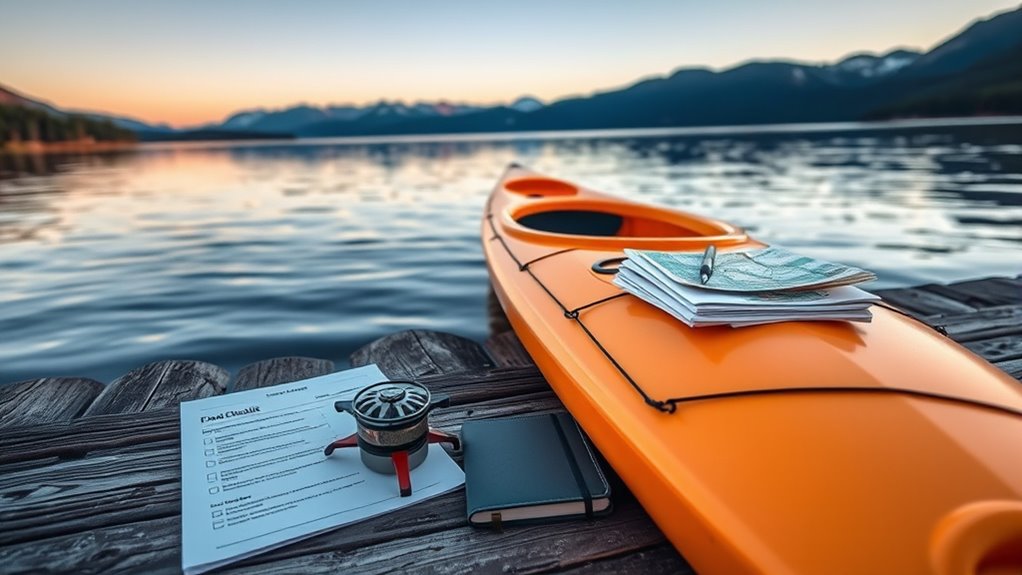
Before heading out on your multi-day kayaking trip, it’s crucial to go through a final checklist to confirm everything is in place. Review your packing essentials, making sure you have waterproof gear, navigation tools, and safety equipment. Remember to follow leave no trace principles to protect the environment. Double-check your communication devices and emergency supplies. Use this table to guide your review:
| Item | Confirmed | Notes |
|---|---|---|
| Waterproof clothing | Yes | Extra layers for cold |
| Food and water | Yes | Enough for entire trip |
| Safety gear (PFD, whistle) | Yes | Check condition |
| Leave no trace supplies | Yes | Trash bags, utensils |
| Navigation tools | Yes | Map, GPS, compass |
Completing this review helps guarantee safety, preparedness, and environmental respect during your adventure.
Frequently Asked Questions
How Do I Choose the Best Time of Year for a Multi-Day Kayaking Trip?
You should consider seasonal considerations like weather, water levels, and daylight hours to pick the best time for your trip. Aim to avoid peak seasons to dodge crowded spots and enjoy a more peaceful experience. Research local climate trends and plan during shoulder seasons or off-peak times. This way, you can fully immerse yourself in nature, stay safe, and have a more enjoyable multi-day kayaking adventure.
What Are Common Safety Concerns During Extended Kayaking Adventures?
Think of safety concerns during extended kayaking as your guiding stars. You need to master marine navigation, so you don’t get lost in open waters, and practice knot tying to secure gear and handle emergencies. Weather changes, fatigue, and dehydration also pose risks. Staying vigilant, planning your route carefully, and carrying essential safety gear help keep your adventure afloat and enjoyable. Remember, safety is the anchor of every successful trip.
How Can I Prevent and Manage Potential Wildlife Encounters?
To prevent and manage wildlife encounters, you should practice proper wildlife identification and avoid surprising animals. Keep a respectful distance, especially from aggressive species, and use binoculars or a camera for wildlife photography instead of approaching closely. Make noise periodically to alert animals of your presence, and carry bear spray if in bear territory. Staying aware and respectful helps guarantee safe, enjoyable paddling while observing nature’s beauty.
What Are Tips for Maintaining Energy and Morale Over Multiple Days?
Imagine your energy as a campfire; keep it burning bright with proper nutrition planning and rest strategies. You’ll want to pack high-energy snacks and stay hydrated to avoid crashes. Take regular breaks to stretch and reset your focus, just like re-stoking a fire. By managing your fuel and rest, you’ll maintain morale and stamina, making each paddle stroke more manageable and your trip more enjoyable.
How Should I Handle Unexpected Weather Changes or Water Conditions?
When unexpected weather changes or water conditions occur, stay calm and use your weather preparedness skills. Check water forecasting apps frequently, and have a plan for shelter or safe zones. Adjust your route if needed, and slow down to handle rough waters safely. Always carry appropriate gear like rain jackets, extra clothing, and safety equipment. Your quick decision-making and preparedness will keep you safe and comfortable despite changing conditions.
Conclusion
As you finish planning your multi-day kayaking trip, remember that sometimes the best adventures come from unexpected moments—like a sudden rain shower or a friendly encounter on the water. Trust your preparation, stay flexible, and embrace the surprises along the way. The most memorable trips are often those where you adapt and find joy in the unforeseen. So, pack smart, stay safe, and let the water guide you to unforgettable experiences.

